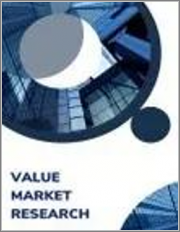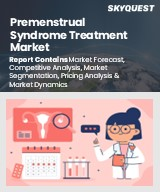
|
시장보고서
상품코드
1421092
세계의 항불안제 시장 : 산업 분석, 규모, 점유율, 성장, 동향, 예측(2024-2032년)Global Anti-Anxiety Drug Market Research Report - Industry Analysis, Size, Share, Growth, Trends and Forecast 2024 to 2032 |
||||||
세계 항불안제 시장 규모는 2023년 157억 4,000만 달러에 달하고, 2024년부터 2032년까지 연평균 5.28% 성장하여 2032년에는 약 250억 1,000만 달러에 달할 것으로 예상됩니다.
항불안제는 항불안약이라고도 하며, 불안 장애의 증상을 완화하기 위해 개발된 약물입니다. 이러한 장애는 과도한 걱정, 두려움, 과민 반응을 특징으로하는 정신 건강 상태이며 종종 큰 고통과 일상적인 기능 장애를 초래하는 경우가 많습니다. 이 약물은 중추신경계에 작용하여 불안 증상의 강도를 감소시킵니다.
시장 역학
항불안제 시장은 여러 가지 상호 연관된 요인에 의해 주도되고 있습니다. 전 세계적으로 정신 건강 문제에 대한 인식과 수용도가 높아지면서 불안 장애의 유병률 증가와 함께 항불안제 수요 증가에 기여하고 있습니다. 의약품 연구 개발의 지속적인 발전은 새로운 화합물과 제형의 발견으로 이어져 약물의 효능을 향상시키고 있습니다. 불안 장애에 대한 감수성이 높은 세계 인구의 고령화는 시장 성장을 더욱 촉진하고 있습니다. 또한, 스트레스 수준이 증가하는 현대인의 라이프스타일, 확대되는 의료 인프라, 정신 건강 연구를 지원하는 규제 환경의 변화도 시장 확대에 기여하고 있습니다. 처방률의 증가와 원격 의료, 디지털 헬스 등 치료 방법의 기술 발전도 중요한 역할을 하고 있습니다. 그러나 과잉 처방과 부작용에 대한 우려, 치료와 생활습관 개입을 포함한 종합적인 정신건강 접근법의 필요성 등이 과제로 남아있습니다.
조사 보고서는 Porter's Five Forces 모델, 시장 매력도 분석, 밸류체인 분석을 다루고 있습니다. 이러한 도구는 산업 구조를 명확하게 파악하고 세계 수준에서 경쟁의 매력을 평가하는 데 도움이 될 수 있습니다. 또한 이러한 도구는 세계 항불안제 시장의 각 부문을 포괄적으로 평가할 수 있습니다. 항불안제 산업의 성장과 동향은 이 조사에 대한 전체적인 접근 방식을 제공합니다.
시장 세분화
항불안제 시장 보고서의 이 섹션에서는 국가 및 지역 수준의 부문에 대한 자세한 데이터를 제공하여 전략가가 향후 기회를 통해 각 제품 및 서비스의 대상 고객을 식별하는 데 도움이 될 것입니다.
지역 분석
이 섹션에서는 북미, 유럽, 아시아태평양, 라틴아메리카, 중동 및 아프리카의 항불안제 시장의 현재와 미래 수요를 강조하는 지역 전망을 다룹니다. 또한, 이 보고서는 모든 주요 지역의 개별 애플리케이션 부문의 수요, 추정 및 예측에 초점을 맞추고 있습니다.
맞춤형 요구 사항이 있는 경우 당사에 문의하십시오. 저희 조사팀은 고객의 요구에 따라 맞춤형 보고서를 제공 할 수 있습니다.
목차
제1장 서문
제2장 주요 요약
- 시장 하이라이트
- 세계 시장 현황
제3장 항불안제 - 업계 분석
- 서론 : 시장 역학
- 시장 성장 촉진요인
- 시장 성장 억제요인
- 시장 기회
- 업계 동향
- Porter's Five Forces 분석
- 시장 매력도 분석
제4장 밸류체인 분석
- 밸류체인 분석
- 원재료 분석
- 원재료 리스트
- 원재료 제조업체 리스트
- 주요 원재료 가격 동향
- 잠재적 바이어 리스트
- 마케팅 채널
- 직접 마케팅
- 간접 마케팅
- 마케팅 채널 발전 동향
제5장 항불안제 세계 시장 분석 : 약제 클래스별
- 개요 : 약제 클래스별
- 실적 데이터와 예측 데이터
- 분석 : 약제 클래스별
- Selective Serotonin Reuptake Inhibitors(SSRIs)
- Benzodiazepines
- Serotonin-Norepinephrine Reuptake Inhibitors(SNRIs)
- Beta Blockers
제6장 항불안제 세계 시장 분석 : 유통 채널별
- 개요 : 유통 채널별
- 실적 데이터와 예측 데이터
- 분석 : 유통 채널별
- 병원 약국
- 소매 약국/드럭스토어
- 온라인 약국
제7장 항불안제 세계 시장 분석 : 지역별
- 전망 : 지역별
- 서론
- 북미 매출 분석
- 개요, 실적과 예측
- 북미 : 부문별
- 북미 : 국가별
- 미국
- 캐나다
- 멕시코
- 유럽 매출 분석
- 개요, 실적과 예측
- 유럽 : 부문별
- 유럽 : 국가별
- 영국
- 프랑스
- 독일
- 이탈리아
- 러시아
- 기타 유럽
- 아시아태평양 매출 분석
- 개요, 실적과 예측
- 아시아태평양 : 부문별
- 아시아태평양 : 국가별
- 중국
- 인도
- 일본
- 한국
- 호주
- 동남아시아
- 기타 아시아태평양
- 라틴아메리카 매출 분석
- 개요, 실적과 예측
- 라틴아메리카 : 부문별
- 라틴아메리카 : 국가별
- 브라질
- 아르헨티나
- 페루
- 칠레
- 기타 라틴아메리카
- 중동 및 아프리카 매출 분석
- 개요, 실적과 예측
- 중동 및 아프리카 : 부문별
- 중동 및 아프리카 : 국가별
- 사우디아라비아
- 아랍에미리트
- 이스라엘
- 남아프리카공화국
- 기타 중동 및 아프리카
제8장 항불안제 기업 경쟁 상황
- 항불안제 시장 경쟁
- 제휴, 협력, 합의
- 인수합병
- 신제품 출시
- 기타 개발
제9장 기업 개요
- 상위 기업의 시장 점유율 분석
- 시장 집중도
- Pfizer Inc.
- Eli Lilly and Company
- GlaxoSmithKline plc
- Johnson & Johnson
- AstraZeneca plc
- Roche Holding AG
- Forest Laboratories(a subsidiary of Allergan
- now part of AbbVie)
- Bristol Myers Squibb Company
- Sanofi S.A.
- Lundbeck A/S
The global demand for Anti-Anxiety Drug Market is presumed to reach the market size of nearly USD 25.01 Billion by 2032 from USD 15.74 Billion in 2023 with a CAGR of 5.28% under the study period 2024 - 2032.
Anti-anxiety drugs, also known as anxiolytics, are medications designed to relieve symptoms of anxiety disorders. These disorders are mental health conditions characterized by excessive worry, fear, or nervousness, often leading to significant distress or impairment in daily functioning. These drugs work by affecting the central nervous system to reduce the intensity of anxiety symptoms.
MARKET DYNAMICS
The anti-anxiety drug market is propelled by several interconnected factors. Rising global awareness and acceptance of mental health issues, coupled with an increasing prevalence of anxiety disorders, contribute to a growing demand for anti-anxiety medications. Ongoing advancements in pharmaceutical research and development lead to the discovery of novel compounds and formulations, enhancing the effectiveness of these medications. The aging global population, characterized by a higher susceptibility to anxiety disorders, further boosts market growth. Additionally, modern lifestyles with elevated stress levels, expanding healthcare infrastructure, and changing regulatory environments supporting mental health research contribute to the market's expansion. Increased prescription rates and technological advancements in treatment modalities, such as telemedicine and digital health, also play pivotal roles. However, challenges include concerns about over-prescription, potential side effects, and the need for a comprehensive mental health approach encompassing therapy and lifestyle interventions.
The research report covers Porter's Five Forces Model, Market Attractiveness Analysis, and Value Chain analysis. These tools help to get a clear picture of the industry's structure and evaluate the competition attractiveness at a global level. Additionally, these tools also give an inclusive assessment of each segment in the global market of anti-anxiety drug. The growth and trends of anti-anxiety drug industry provide a holistic approach to this study.
MARKET SEGMENTATION
This section of the anti-anxiety drug market report provides detailed data on the segments at country and regional level, thereby assisting the strategist in identifying the target demographics for the respective product or services with the upcoming opportunities.
By Drug Class
- Selective Serotonin Reuptake Inhibitors (SSRIs)
- Benzodiazepines
- Serotonin-Norepinephrine Reuptake Inhibitors (SNRIs)
- Beta Blockers
By Distribution Channel
- Hospital Pharmacies
- Retail Pharmacies/Drug Stores
- Online Pharmacies
REGIONAL ANALYSIS
This section covers the regional outlook, which accentuates current and future demand for the Anti-Anxiety Drug market across North America, Europe, Asia-Pacific, Latin America, and Middle East & Africa. Further, the report focuses on demand, estimation, and forecast for individual application segments across all the prominent regions.
The research report also covers the comprehensive profiles of the key players in the market and an in-depth view of the competitive landscape worldwide. The major players in the Anti-Anxiety Drug market include Pfizer Inc., Eli Lilly and Company, GlaxoSmithKline plc, Johnson & Johnson, AstraZeneca plc, Roche Holding AG, Forest Laboratories (a subsidiary of Allergan, now part of AbbVie), Bristol Myers Squibb Company, Sanofi S.A., Lundbeck A/S. This section consists of a holistic view of the competitive landscape that includes various strategic developments such as key mergers & acquisitions, future capacities, partnerships, financial overviews, collaborations, new product developments, new product launches, and other developments.
In case you have any custom requirements, do write to us. Our research team can offer a customized report as per your need.
TABLE OF CONTENTS
1 . PREFACE
- 1.1. Report Description
- 1.1.1. Objective
- 1.1.2. Target Audience
- 1.1.3. Unique Selling Proposition (USP) & offerings
- 1.2. Research Scope
- 1.3. Research Methodology
- 1.3.1. Market Research Process
- 1.3.2. Market Research Methodology
2 . EXECUTIVE SUMMARY
- 2.1. Highlights of Market
- 2.2. Global Market Snapshot
3 . ANTI-ANXIETY DRUG - INDUSTRY ANALYSIS
- 3.1. Introduction - Market Dynamics
- 3.2. Market Drivers
- 3.3. Market Restraints
- 3.4. Opportunities
- 3.5. Industry Trends
- 3.6. Porter's Five Force Analysis
- 3.7. Market Attractiveness Analysis
- 3.7.1 Market Attractiveness Analysis By Drug Class
- 3.7.2 Market Attractiveness Analysis By Distribution Channel
- 3.7.3 Market Attractiveness Analysis By Region
4 . VALUE CHAIN ANALYSIS
- 4.1. Value Chain Analysis
- 4.2. Raw Material Analysis
- 4.2.1. List of Raw Materials
- 4.2.2. Raw Material Manufactures List
- 4.2.3. Price Trend of Key Raw Materials
- 4.3. List of Potential Buyers
- 4.4. Marketing Channel
- 4.4.1. Direct Marketing
- 4.4.2. Indirect Marketing
- 4.4.3. Marketing Channel Development Trend
5 . GLOBAL ANTI-ANXIETY DRUG MARKET ANALYSIS BY DRUG CLASS
- 5.1 Overview by Drug Class
- 5.2 Historical and Forecast Data
- 5.3 Analysis by Drug Class
- 5.4 Selective Serotonin Reuptake Inhibitors (SSRIs) Historic and Forecast Sales by Regions
- 5.5 Benzodiazepines Historic and Forecast Sales by Regions
- 5.6 Serotonin-Norepinephrine Reuptake Inhibitors (SNRIs) Historic and Forecast Sales by Regions
- 5.7 Beta Blockers Historic and Forecast Sales by Regions
6 . GLOBAL ANTI-ANXIETY DRUG MARKET ANALYSIS BY DISTRIBUTION CHANNEL
- 6.1 Overview by Distribution Channel
- 6.2 Historical and Forecast Data
- 6.3 Analysis by Distribution Channel
- 6.4 Hospital Pharmacies Historic and Forecast Sales by Regions
- 6.5 Retail Pharmacies/Drug Stores Historic and Forecast Sales by Regions
- 6.6 Online Pharmacies Historic and Forecast Sales by Regions
7 . GLOBAL ANTI-ANXIETY DRUG MARKET ANALYSIS BY GEOGRAPHY
- 7.1. Regional Outlook
- 7.2. Introduction
- 7.3. North America Sales Analysis
- 7.3.1. Overview, Historic and Forecast Data Sales Analysis
- 7.3.2. North America By Segment Sales Analysis
- 7.3.3. North America By Country Sales Analysis
- 7.3.4. United State Sales Analysis
- 7.3.5. Canada Sales Analysis
- 7.3.6. Mexico Sales Analysis
- 7.4. Europe Sales Analysis
- 7.4.1. Overview, Historic and Forecast Data Sales Analysis
- 7.4.2. Europe by Segment Sales Analysis
- 7.4.3. Europe by Country Sales Analysis
- 7.4.4. United Kingdom Sales Analysis
- 7.4.5. France Sales Analysis
- 7.4.6. Germany Sales Analysis
- 7.4.7. Italy Sales Analysis
- 7.4.8. Russia Sales Analysis
- 7.4.9. Rest Of Europe Sales Analysis
- 7.5. Asia Pacific Sales Analysis
- 7.5.1. Overview, Historic and Forecast Data Sales Analysis
- 7.5.2. Asia Pacific by Segment Sales Analysis
- 7.5.3. Asia Pacific by Country Sales Analysis
- 7.5.4. China Sales Analysis
- 7.5.5. India Sales Analysis
- 7.5.6. Japan Sales Analysis
- 7.5.7. South Korea Sales Analysis
- 7.5.8. Australia Sales Analysis
- 7.5.9. South East Asia Sales Analysis
- 7.5.10. Rest Of Asia Pacific Sales Analysis
- 7.6. Latin America Sales Analysis
- 7.6.1. Overview, Historic and Forecast Data Sales Analysis
- 7.6.2. Latin America by Segment Sales Analysis
- 7.6.3. Latin America by Country Sales Analysis
- 7.6.4. Brazil Sales Analysis
- 7.6.5. Argentina Sales Analysis
- 7.6.6. Peru Sales Analysis
- 7.6.7. Chile Sales Analysis
- 7.6.8. Rest of Latin America Sales Analysis
- 7.7. Middle East & Africa Sales Analysis
- 7.7.1. Overview, Historic and Forecast Data Sales Analysis
- 7.7.2. Middle East & Africa by Segment Sales Analysis
- 7.7.3. Middle East & Africa by Country Sales Analysis
- 7.7.4. Saudi Arabia Sales Analysis
- 7.7.5. UAE Sales Analysis
- 7.7.6. Israel Sales Analysis
- 7.7.7. South Africa Sales Analysis
- 7.7.8. Rest Of Middle East And Africa Sales Analysis
8 . COMPETITIVE LANDSCAPE OF THE ANTI-ANXIETY DRUG COMPANIES
- 8.1. Anti-Anxiety Drug Market Competition
- 8.2. Partnership/Collaboration/Agreement
- 8.3. Merger And Acquisitions
- 8.4. New Product Launch
- 8.5. Other Developments
9 . COMPANY PROFILES OF ANTI-ANXIETY DRUG INDUSTRY
- 9.1. Top Companies Market Share Analysis
- 9.2. Market Concentration Rate
- 9.3. Pfizer Inc.
- 9.3.1. Company Overview
- 9.3.2. Company Revenue
- 9.3.3. Products
- 9.3.4. Recent Developments
- 9.4. Eli Lilly and Company
- 9.4.1. Company Overview
- 9.4.2. Company Revenue
- 9.4.3. Products
- 9.4.4. Recent Developments
- 9.5. GlaxoSmithKline plc
- 9.5.1. Company Overview
- 9.5.2. Company Revenue
- 9.5.3. Products
- 9.5.4. Recent Developments
- 9.6. Johnson & Johnson
- 9.6.1. Company Overview
- 9.6.2. Company Revenue
- 9.6.3. Products
- 9.6.4. Recent Developments
- 9.7. AstraZeneca plc
- 9.7.1. Company Overview
- 9.7.2. Company Revenue
- 9.7.3. Products
- 9.7.4. Recent Developments
- 9.8. Roche Holding AG
- 9.8.1. Company Overview
- 9.8.2. Company Revenue
- 9.8.3. Products
- 9.8.4. Recent Developments
- 9.9. Forest Laboratories (a subsidiary of Allergan
- 9.9.1. Company Overview
- 9.9.2. Company Revenue
- 9.9.3. Products
- 9.9.4. Recent Developments
- 9.10. now part of AbbVie)
- 9.10.1. Company Overview
- 9.10.2. Company Revenue
- 9.10.3. Products
- 9.10.4. Recent Developments
- 9.11. Bristol Myers Squibb Company
- 9.11.1. Company Overview
- 9.11.2. Company Revenue
- 9.11.3. Products
- 9.11.4. Recent Developments
- 9.12. Sanofi S.A.
- 9.12.1. Company Overview
- 9.12.2. Company Revenue
- 9.12.3. Products
- 9.12.4. Recent Developments
- 9.13. Lundbeck A/S
- 9.13.1. Company Overview
- 9.13.2. Company Revenue
- 9.13.3. Products
- 9.13.4. Recent Developments



















